Financial and Economic Literacy for Managers - Analysis and Report
VerifiedAdded on 2020/06/06
|13
|3473
|65
Report
AI Summary
This report delves into financial and economic literacy for managers, encompassing key concepts such as the performance paradigm, globalization, and their application to companies like Amazon. It examines the interplay of demand and supply, including elasticity, and explores various economic policies, including competitive, fiscal, and supply-side policies. The report also covers financial planning, control, capital budgeting, and the use of financial instruments. Furthermore, it includes calculations of financial ratios, future value, and NPV analysis, providing a comprehensive overview of financial management principles and their practical application in a business context. The report aims to enhance understanding of financial decision-making and promote sustainable growth.
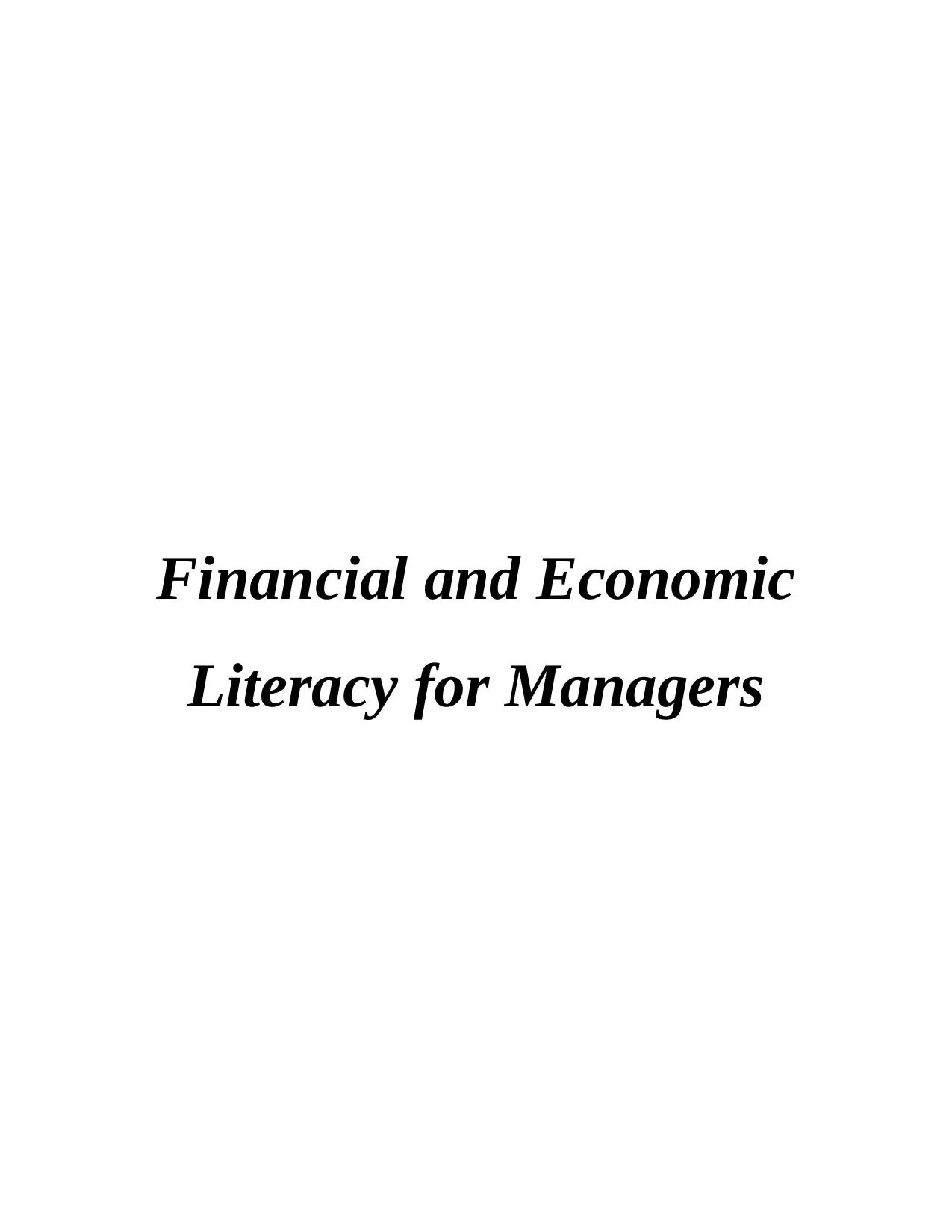
Financial and Economic
Literacy for Managers
Literacy for Managers
Paraphrase This Document
Need a fresh take? Get an instant paraphrase of this document with our AI Paraphraser
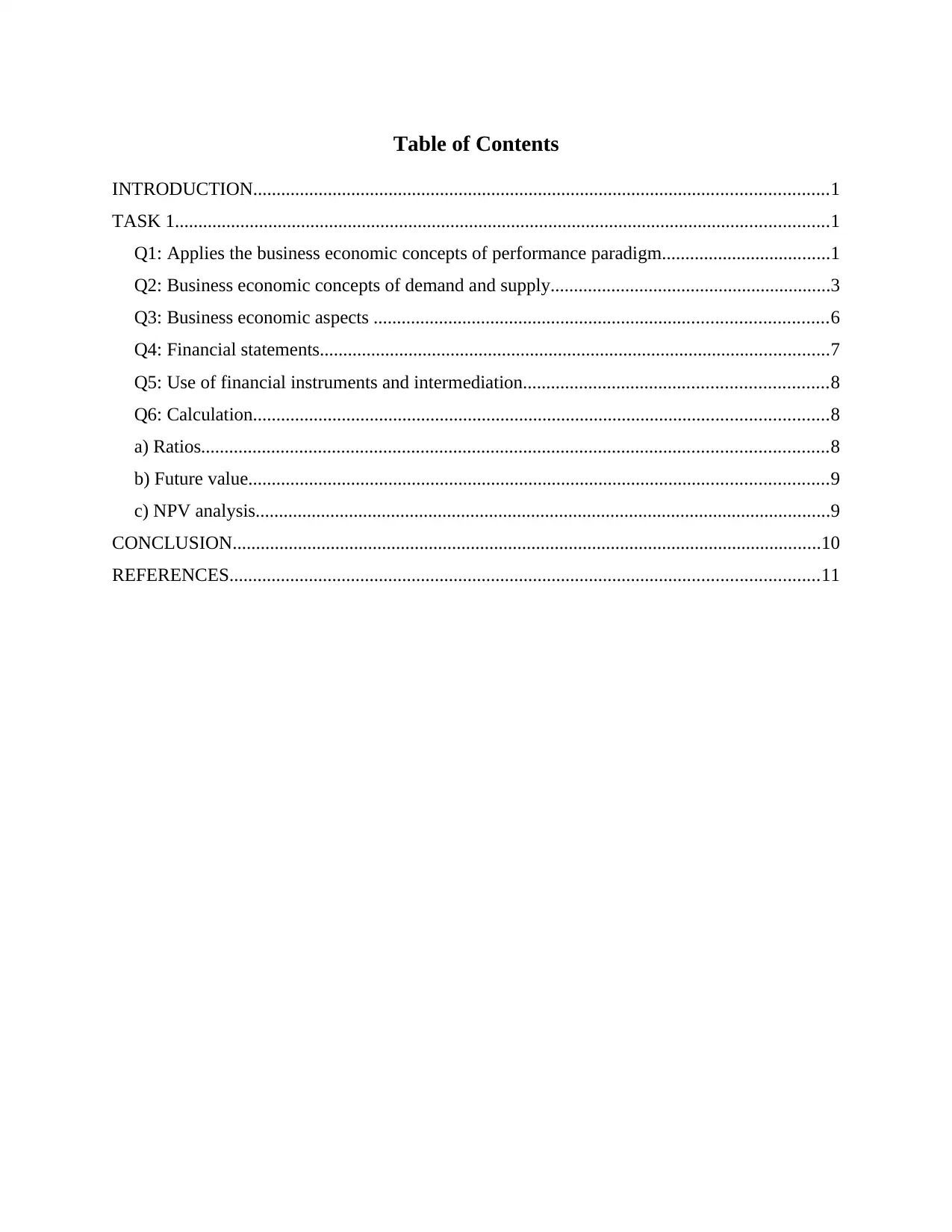
Table of Contents
INTRODUCTION...........................................................................................................................1
TASK 1............................................................................................................................................1
Q1: Applies the business economic concepts of performance paradigm....................................1
Q2: Business economic concepts of demand and supply............................................................3
Q3: Business economic aspects .................................................................................................6
Q4: Financial statements.............................................................................................................7
Q5: Use of financial instruments and intermediation.................................................................8
Q6: Calculation...........................................................................................................................8
a) Ratios......................................................................................................................................8
b) Future value............................................................................................................................9
c) NPV analysis...........................................................................................................................9
CONCLUSION..............................................................................................................................10
REFERENCES..............................................................................................................................11
INTRODUCTION...........................................................................................................................1
TASK 1............................................................................................................................................1
Q1: Applies the business economic concepts of performance paradigm....................................1
Q2: Business economic concepts of demand and supply............................................................3
Q3: Business economic aspects .................................................................................................6
Q4: Financial statements.............................................................................................................7
Q5: Use of financial instruments and intermediation.................................................................8
Q6: Calculation...........................................................................................................................8
a) Ratios......................................................................................................................................8
b) Future value............................................................................................................................9
c) NPV analysis...........................................................................................................................9
CONCLUSION..............................................................................................................................10
REFERENCES..............................................................................................................................11
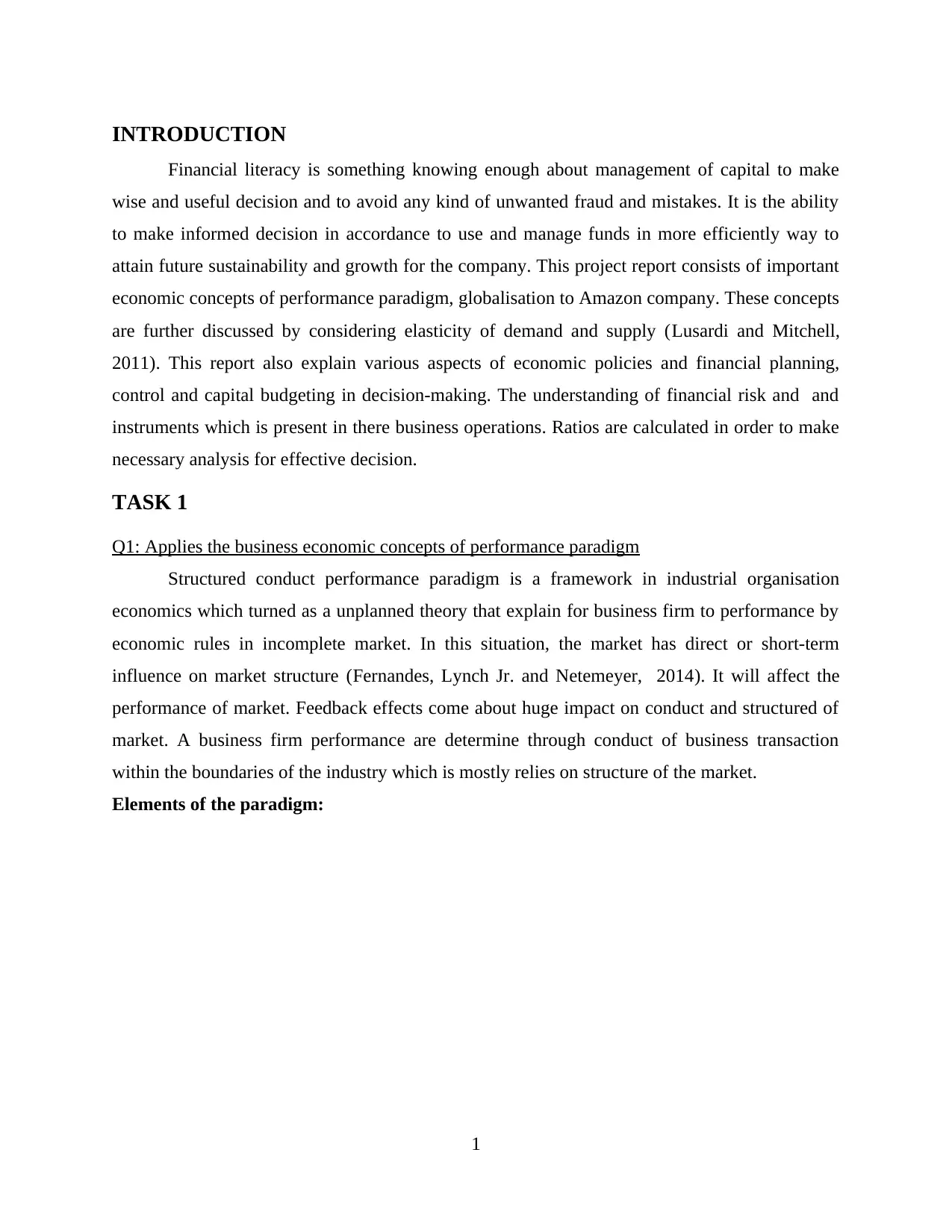
INTRODUCTION
Financial literacy is something knowing enough about management of capital to make
wise and useful decision and to avoid any kind of unwanted fraud and mistakes. It is the ability
to make informed decision in accordance to use and manage funds in more efficiently way to
attain future sustainability and growth for the company. This project report consists of important
economic concepts of performance paradigm, globalisation to Amazon company. These concepts
are further discussed by considering elasticity of demand and supply (Lusardi and Mitchell,
2011). This report also explain various aspects of economic policies and financial planning,
control and capital budgeting in decision-making. The understanding of financial risk and and
instruments which is present in there business operations. Ratios are calculated in order to make
necessary analysis for effective decision.
TASK 1
Q1: Applies the business economic concepts of performance paradigm
Structured conduct performance paradigm is a framework in industrial organisation
economics which turned as a unplanned theory that explain for business firm to performance by
economic rules in incomplete market. In this situation, the market has direct or short-term
influence on market structure (Fernandes, Lynch Jr. and Netemeyer, 2014). It will affect the
performance of market. Feedback effects come about huge impact on conduct and structured of
market. A business firm performance are determine through conduct of business transaction
within the boundaries of the industry which is mostly relies on structure of the market.
Elements of the paradigm:
1
Financial literacy is something knowing enough about management of capital to make
wise and useful decision and to avoid any kind of unwanted fraud and mistakes. It is the ability
to make informed decision in accordance to use and manage funds in more efficiently way to
attain future sustainability and growth for the company. This project report consists of important
economic concepts of performance paradigm, globalisation to Amazon company. These concepts
are further discussed by considering elasticity of demand and supply (Lusardi and Mitchell,
2011). This report also explain various aspects of economic policies and financial planning,
control and capital budgeting in decision-making. The understanding of financial risk and and
instruments which is present in there business operations. Ratios are calculated in order to make
necessary analysis for effective decision.
TASK 1
Q1: Applies the business economic concepts of performance paradigm
Structured conduct performance paradigm is a framework in industrial organisation
economics which turned as a unplanned theory that explain for business firm to performance by
economic rules in incomplete market. In this situation, the market has direct or short-term
influence on market structure (Fernandes, Lynch Jr. and Netemeyer, 2014). It will affect the
performance of market. Feedback effects come about huge impact on conduct and structured of
market. A business firm performance are determine through conduct of business transaction
within the boundaries of the industry which is mostly relies on structure of the market.
Elements of the paradigm:
1
⊘ This is a preview!⊘
Do you want full access?
Subscribe today to unlock all pages.

Trusted by 1+ million students worldwide
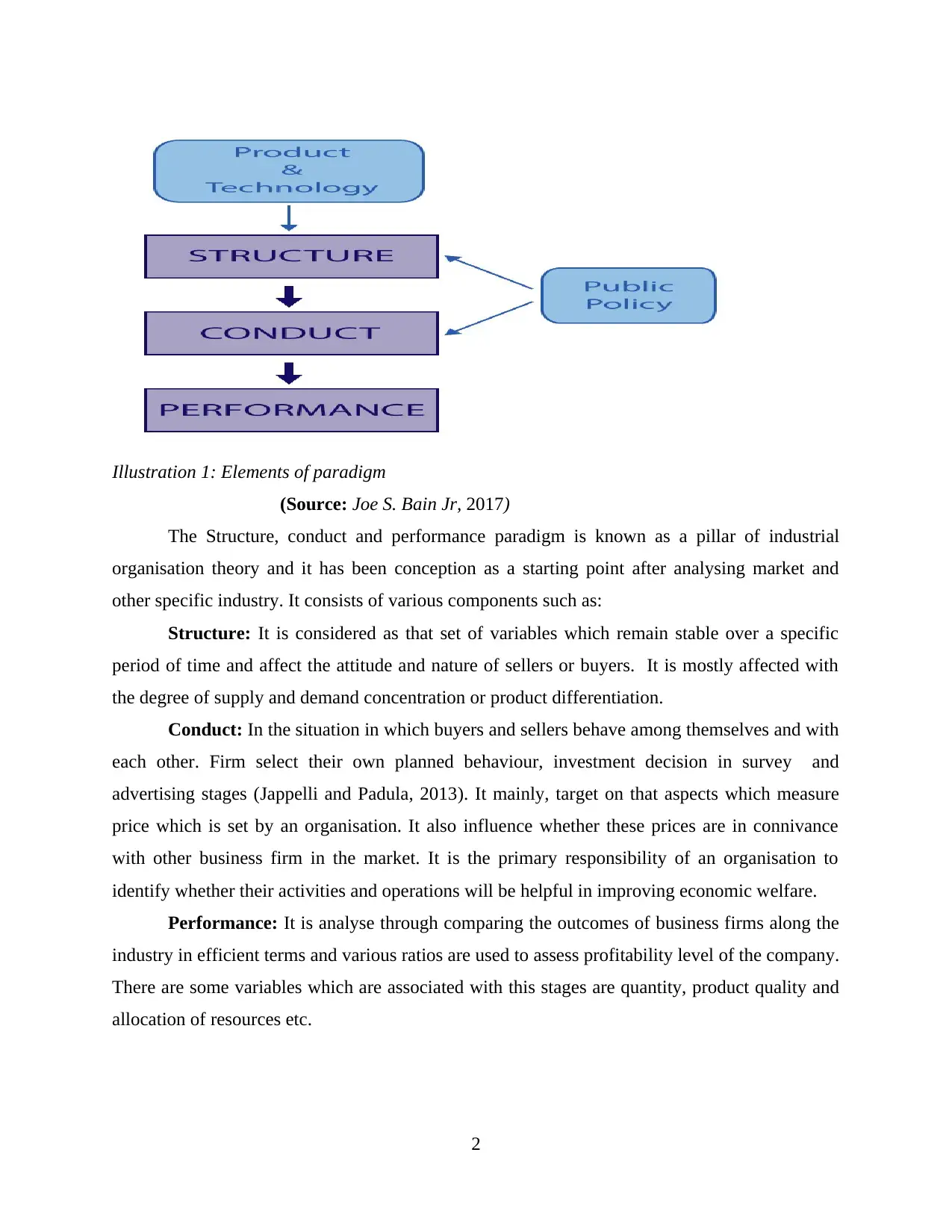
Illustration 1: Elements of paradigm
(Source: Joe S. Bain Jr, 2017)
The Structure, conduct and performance paradigm is known as a pillar of industrial
organisation theory and it has been conception as a starting point after analysing market and
other specific industry. It consists of various components such as:
Structure: It is considered as that set of variables which remain stable over a specific
period of time and affect the attitude and nature of sellers or buyers. It is mostly affected with
the degree of supply and demand concentration or product differentiation.
Conduct: In the situation in which buyers and sellers behave among themselves and with
each other. Firm select their own planned behaviour, investment decision in survey and
advertising stages (Jappelli and Padula, 2013). It mainly, target on that aspects which measure
price which is set by an organisation. It also influence whether these prices are in connivance
with other business firm in the market. It is the primary responsibility of an organisation to
identify whether their activities and operations will be helpful in improving economic welfare.
Performance: It is analyse through comparing the outcomes of business firms along the
industry in efficient terms and various ratios are used to assess profitability level of the company.
There are some variables which are associated with this stages are quantity, product quality and
allocation of resources etc.
2
(Source: Joe S. Bain Jr, 2017)
The Structure, conduct and performance paradigm is known as a pillar of industrial
organisation theory and it has been conception as a starting point after analysing market and
other specific industry. It consists of various components such as:
Structure: It is considered as that set of variables which remain stable over a specific
period of time and affect the attitude and nature of sellers or buyers. It is mostly affected with
the degree of supply and demand concentration or product differentiation.
Conduct: In the situation in which buyers and sellers behave among themselves and with
each other. Firm select their own planned behaviour, investment decision in survey and
advertising stages (Jappelli and Padula, 2013). It mainly, target on that aspects which measure
price which is set by an organisation. It also influence whether these prices are in connivance
with other business firm in the market. It is the primary responsibility of an organisation to
identify whether their activities and operations will be helpful in improving economic welfare.
Performance: It is analyse through comparing the outcomes of business firms along the
industry in efficient terms and various ratios are used to assess profitability level of the company.
There are some variables which are associated with this stages are quantity, product quality and
allocation of resources etc.
2
Paraphrase This Document
Need a fresh take? Get an instant paraphrase of this document with our AI Paraphraser
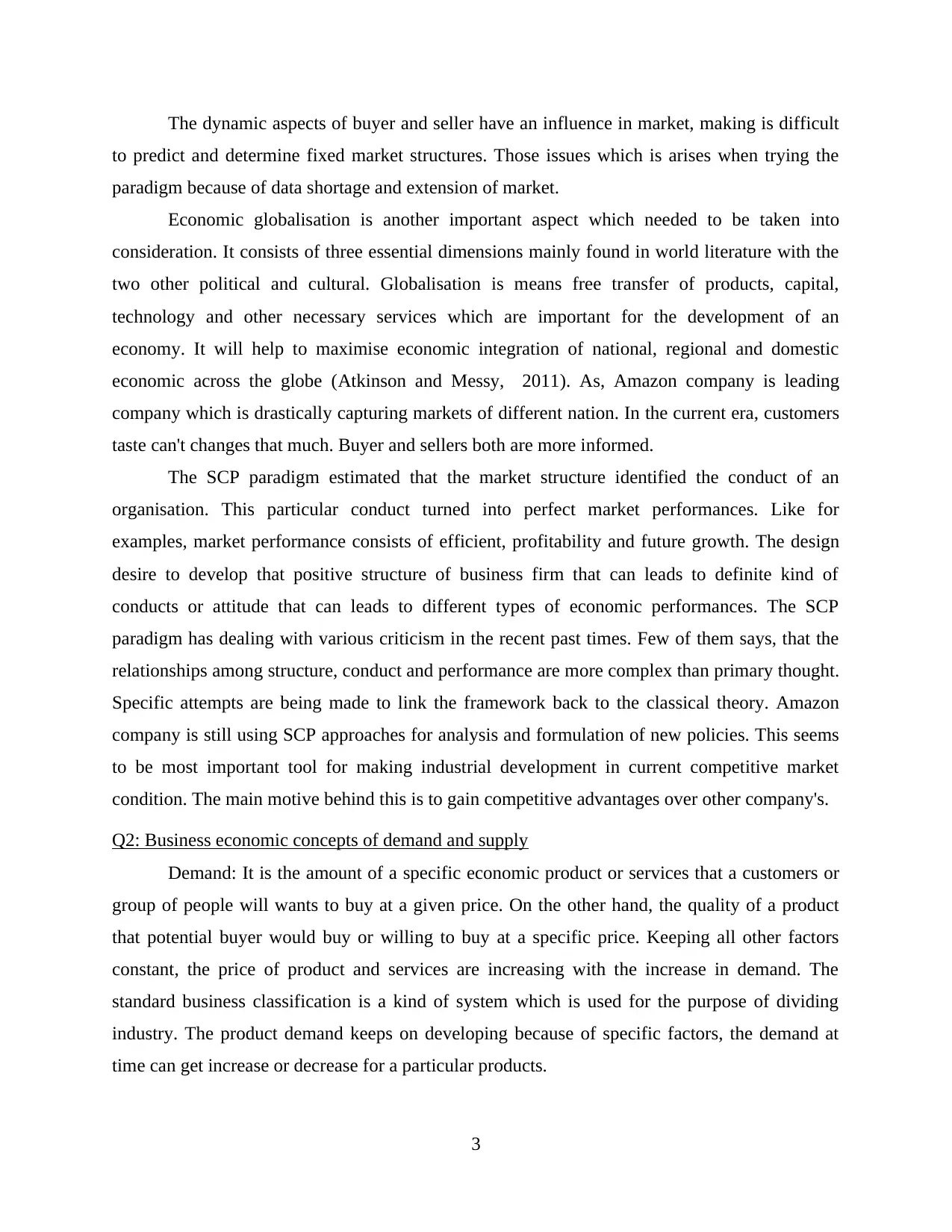
The dynamic aspects of buyer and seller have an influence in market, making is difficult
to predict and determine fixed market structures. Those issues which is arises when trying the
paradigm because of data shortage and extension of market.
Economic globalisation is another important aspect which needed to be taken into
consideration. It consists of three essential dimensions mainly found in world literature with the
two other political and cultural. Globalisation is means free transfer of products, capital,
technology and other necessary services which are important for the development of an
economy. It will help to maximise economic integration of national, regional and domestic
economic across the globe (Atkinson and Messy, 2011). As, Amazon company is leading
company which is drastically capturing markets of different nation. In the current era, customers
taste can't changes that much. Buyer and sellers both are more informed.
The SCP paradigm estimated that the market structure identified the conduct of an
organisation. This particular conduct turned into perfect market performances. Like for
examples, market performance consists of efficient, profitability and future growth. The design
desire to develop that positive structure of business firm that can leads to definite kind of
conducts or attitude that can leads to different types of economic performances. The SCP
paradigm has dealing with various criticism in the recent past times. Few of them says, that the
relationships among structure, conduct and performance are more complex than primary thought.
Specific attempts are being made to link the framework back to the classical theory. Amazon
company is still using SCP approaches for analysis and formulation of new policies. This seems
to be most important tool for making industrial development in current competitive market
condition. The main motive behind this is to gain competitive advantages over other company's.
Q2: Business economic concepts of demand and supply
Demand: It is the amount of a specific economic product or services that a customers or
group of people will wants to buy at a given price. On the other hand, the quality of a product
that potential buyer would buy or willing to buy at a specific price. Keeping all other factors
constant, the price of product and services are increasing with the increase in demand. The
standard business classification is a kind of system which is used for the purpose of dividing
industry. The product demand keeps on developing because of specific factors, the demand at
time can get increase or decrease for a particular products.
3
to predict and determine fixed market structures. Those issues which is arises when trying the
paradigm because of data shortage and extension of market.
Economic globalisation is another important aspect which needed to be taken into
consideration. It consists of three essential dimensions mainly found in world literature with the
two other political and cultural. Globalisation is means free transfer of products, capital,
technology and other necessary services which are important for the development of an
economy. It will help to maximise economic integration of national, regional and domestic
economic across the globe (Atkinson and Messy, 2011). As, Amazon company is leading
company which is drastically capturing markets of different nation. In the current era, customers
taste can't changes that much. Buyer and sellers both are more informed.
The SCP paradigm estimated that the market structure identified the conduct of an
organisation. This particular conduct turned into perfect market performances. Like for
examples, market performance consists of efficient, profitability and future growth. The design
desire to develop that positive structure of business firm that can leads to definite kind of
conducts or attitude that can leads to different types of economic performances. The SCP
paradigm has dealing with various criticism in the recent past times. Few of them says, that the
relationships among structure, conduct and performance are more complex than primary thought.
Specific attempts are being made to link the framework back to the classical theory. Amazon
company is still using SCP approaches for analysis and formulation of new policies. This seems
to be most important tool for making industrial development in current competitive market
condition. The main motive behind this is to gain competitive advantages over other company's.
Q2: Business economic concepts of demand and supply
Demand: It is the amount of a specific economic product or services that a customers or
group of people will wants to buy at a given price. On the other hand, the quality of a product
that potential buyer would buy or willing to buy at a specific price. Keeping all other factors
constant, the price of product and services are increasing with the increase in demand. The
standard business classification is a kind of system which is used for the purpose of dividing
industry. The product demand keeps on developing because of specific factors, the demand at
time can get increase or decrease for a particular products.
3
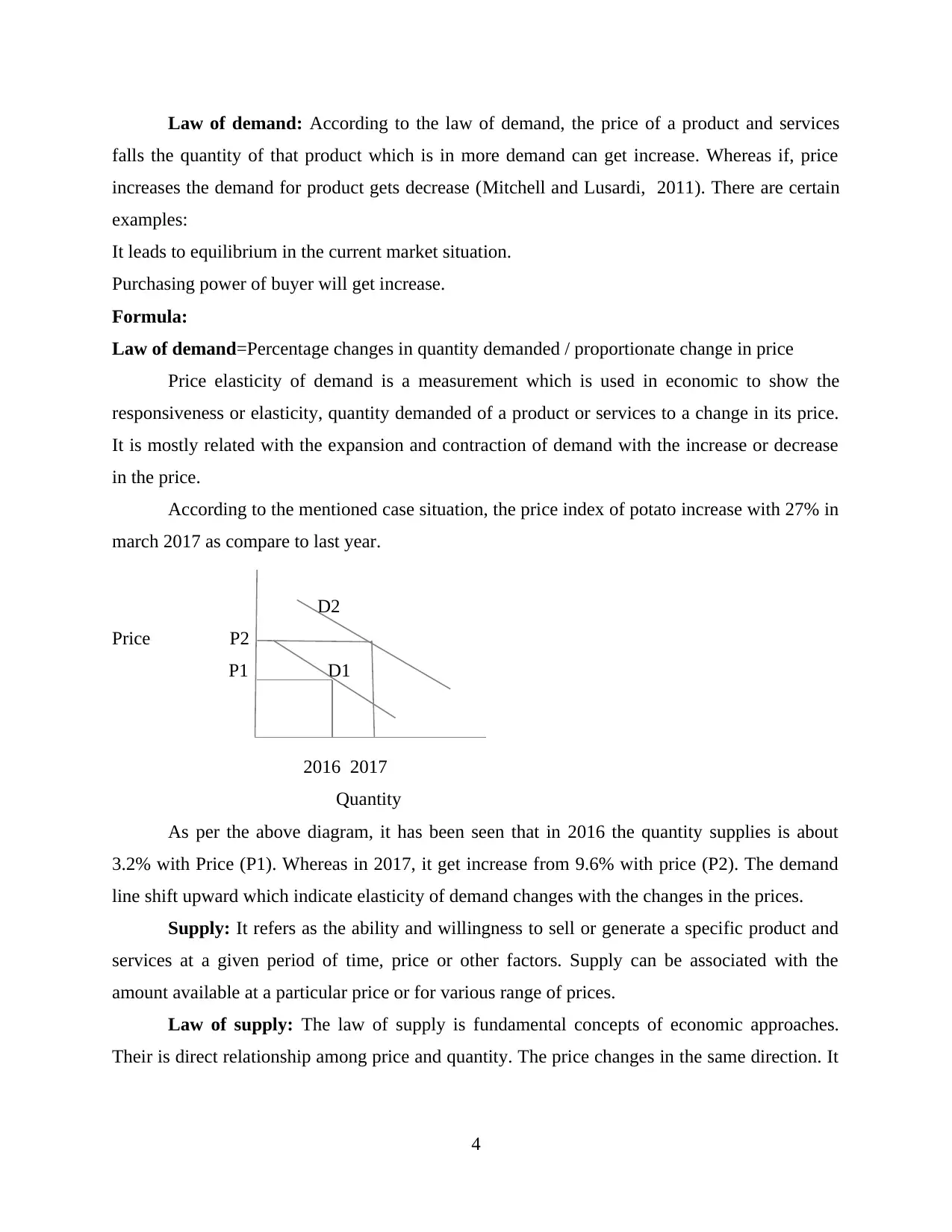
Law of demand: According to the law of demand, the price of a product and services
falls the quantity of that product which is in more demand can get increase. Whereas if, price
increases the demand for product gets decrease (Mitchell and Lusardi, 2011). There are certain
examples:
It leads to equilibrium in the current market situation.
Purchasing power of buyer will get increase.
Formula:
Law of demand=Percentage changes in quantity demanded / proportionate change in price
Price elasticity of demand is a measurement which is used in economic to show the
responsiveness or elasticity, quantity demanded of a product or services to a change in its price.
It is mostly related with the expansion and contraction of demand with the increase or decrease
in the price.
According to the mentioned case situation, the price index of potato increase with 27% in
march 2017 as compare to last year.
D2
Price P2
P1 D1
2016 2017
Quantity
As per the above diagram, it has been seen that in 2016 the quantity supplies is about
3.2% with Price (P1). Whereas in 2017, it get increase from 9.6% with price (P2). The demand
line shift upward which indicate elasticity of demand changes with the changes in the prices.
Supply: It refers as the ability and willingness to sell or generate a specific product and
services at a given period of time, price or other factors. Supply can be associated with the
amount available at a particular price or for various range of prices.
Law of supply: The law of supply is fundamental concepts of economic approaches.
Their is direct relationship among price and quantity. The price changes in the same direction. It
4
falls the quantity of that product which is in more demand can get increase. Whereas if, price
increases the demand for product gets decrease (Mitchell and Lusardi, 2011). There are certain
examples:
It leads to equilibrium in the current market situation.
Purchasing power of buyer will get increase.
Formula:
Law of demand=Percentage changes in quantity demanded / proportionate change in price
Price elasticity of demand is a measurement which is used in economic to show the
responsiveness or elasticity, quantity demanded of a product or services to a change in its price.
It is mostly related with the expansion and contraction of demand with the increase or decrease
in the price.
According to the mentioned case situation, the price index of potato increase with 27% in
march 2017 as compare to last year.
D2
Price P2
P1 D1
2016 2017
Quantity
As per the above diagram, it has been seen that in 2016 the quantity supplies is about
3.2% with Price (P1). Whereas in 2017, it get increase from 9.6% with price (P2). The demand
line shift upward which indicate elasticity of demand changes with the changes in the prices.
Supply: It refers as the ability and willingness to sell or generate a specific product and
services at a given period of time, price or other factors. Supply can be associated with the
amount available at a particular price or for various range of prices.
Law of supply: The law of supply is fundamental concepts of economic approaches.
Their is direct relationship among price and quantity. The price changes in the same direction. It
4
⊘ This is a preview!⊘
Do you want full access?
Subscribe today to unlock all pages.

Trusted by 1+ million students worldwide
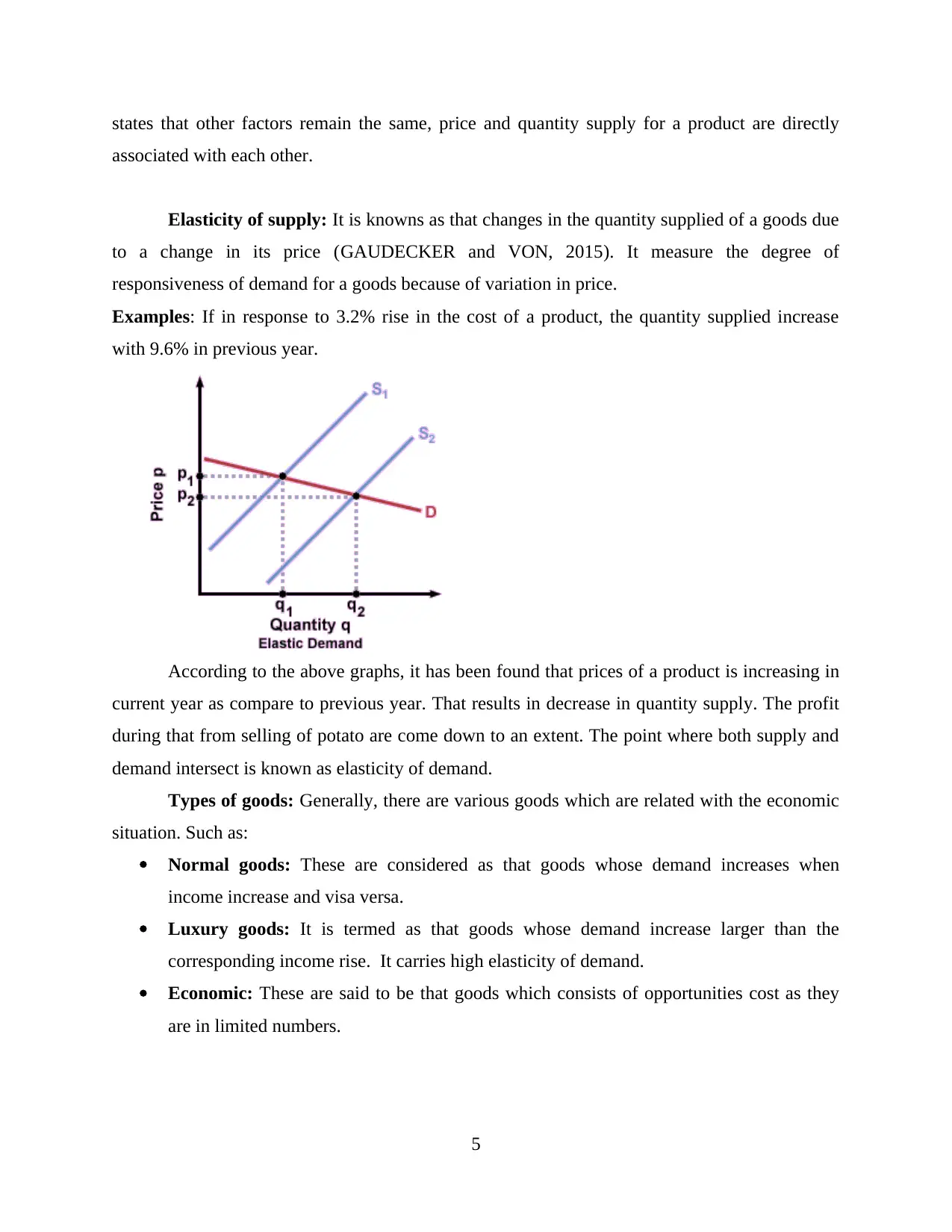
states that other factors remain the same, price and quantity supply for a product are directly
associated with each other.
Elasticity of supply: It is knowns as that changes in the quantity supplied of a goods due
to a change in its price (GAUDECKER and VON, 2015). It measure the degree of
responsiveness of demand for a goods because of variation in price.
Examples: If in response to 3.2% rise in the cost of a product, the quantity supplied increase
with 9.6% in previous year.
According to the above graphs, it has been found that prices of a product is increasing in
current year as compare to previous year. That results in decrease in quantity supply. The profit
during that from selling of potato are come down to an extent. The point where both supply and
demand intersect is known as elasticity of demand.
Types of goods: Generally, there are various goods which are related with the economic
situation. Such as:
Normal goods: These are considered as that goods whose demand increases when
income increase and visa versa.
Luxury goods: It is termed as that goods whose demand increase larger than the
corresponding income rise. It carries high elasticity of demand.
Economic: These are said to be that goods which consists of opportunities cost as they
are in limited numbers.
5
associated with each other.
Elasticity of supply: It is knowns as that changes in the quantity supplied of a goods due
to a change in its price (GAUDECKER and VON, 2015). It measure the degree of
responsiveness of demand for a goods because of variation in price.
Examples: If in response to 3.2% rise in the cost of a product, the quantity supplied increase
with 9.6% in previous year.
According to the above graphs, it has been found that prices of a product is increasing in
current year as compare to previous year. That results in decrease in quantity supply. The profit
during that from selling of potato are come down to an extent. The point where both supply and
demand intersect is known as elasticity of demand.
Types of goods: Generally, there are various goods which are related with the economic
situation. Such as:
Normal goods: These are considered as that goods whose demand increases when
income increase and visa versa.
Luxury goods: It is termed as that goods whose demand increase larger than the
corresponding income rise. It carries high elasticity of demand.
Economic: These are said to be that goods which consists of opportunities cost as they
are in limited numbers.
5
Paraphrase This Document
Need a fresh take? Get an instant paraphrase of this document with our AI Paraphraser
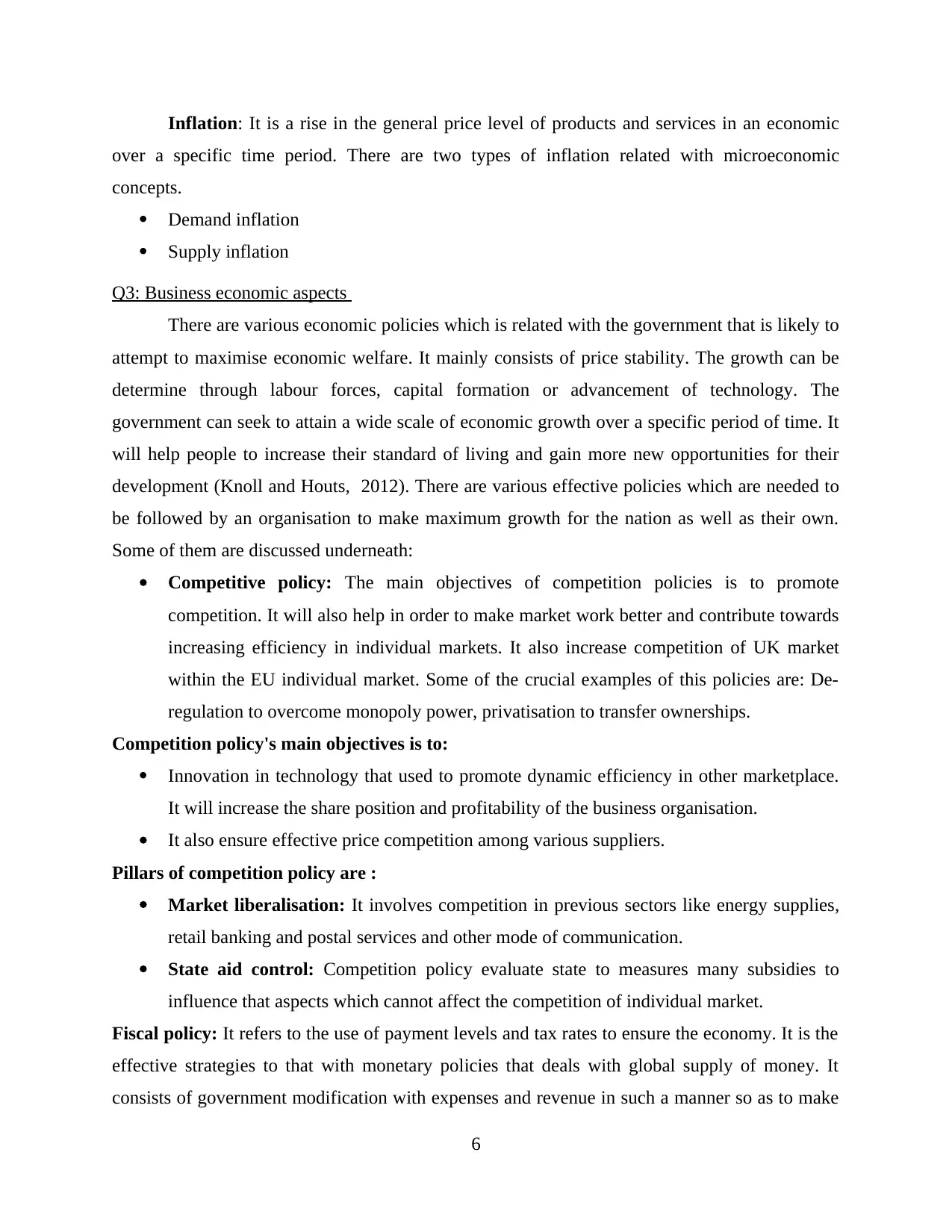
Inflation: It is a rise in the general price level of products and services in an economic
over a specific time period. There are two types of inflation related with microeconomic
concepts.
Demand inflation
Supply inflation
Q3: Business economic aspects
There are various economic policies which is related with the government that is likely to
attempt to maximise economic welfare. It mainly consists of price stability. The growth can be
determine through labour forces, capital formation or advancement of technology. The
government can seek to attain a wide scale of economic growth over a specific period of time. It
will help people to increase their standard of living and gain more new opportunities for their
development (Knoll and Houts, 2012). There are various effective policies which are needed to
be followed by an organisation to make maximum growth for the nation as well as their own.
Some of them are discussed underneath:
Competitive policy: The main objectives of competition policies is to promote
competition. It will also help in order to make market work better and contribute towards
increasing efficiency in individual markets. It also increase competition of UK market
within the EU individual market. Some of the crucial examples of this policies are: De-
regulation to overcome monopoly power, privatisation to transfer ownerships.
Competition policy's main objectives is to:
Innovation in technology that used to promote dynamic efficiency in other marketplace.
It will increase the share position and profitability of the business organisation.
It also ensure effective price competition among various suppliers.
Pillars of competition policy are :
Market liberalisation: It involves competition in previous sectors like energy supplies,
retail banking and postal services and other mode of communication.
State aid control: Competition policy evaluate state to measures many subsidies to
influence that aspects which cannot affect the competition of individual market.
Fiscal policy: It refers to the use of payment levels and tax rates to ensure the economy. It is the
effective strategies to that with monetary policies that deals with global supply of money. It
consists of government modification with expenses and revenue in such a manner so as to make
6
over a specific time period. There are two types of inflation related with microeconomic
concepts.
Demand inflation
Supply inflation
Q3: Business economic aspects
There are various economic policies which is related with the government that is likely to
attempt to maximise economic welfare. It mainly consists of price stability. The growth can be
determine through labour forces, capital formation or advancement of technology. The
government can seek to attain a wide scale of economic growth over a specific period of time. It
will help people to increase their standard of living and gain more new opportunities for their
development (Knoll and Houts, 2012). There are various effective policies which are needed to
be followed by an organisation to make maximum growth for the nation as well as their own.
Some of them are discussed underneath:
Competitive policy: The main objectives of competition policies is to promote
competition. It will also help in order to make market work better and contribute towards
increasing efficiency in individual markets. It also increase competition of UK market
within the EU individual market. Some of the crucial examples of this policies are: De-
regulation to overcome monopoly power, privatisation to transfer ownerships.
Competition policy's main objectives is to:
Innovation in technology that used to promote dynamic efficiency in other marketplace.
It will increase the share position and profitability of the business organisation.
It also ensure effective price competition among various suppliers.
Pillars of competition policy are :
Market liberalisation: It involves competition in previous sectors like energy supplies,
retail banking and postal services and other mode of communication.
State aid control: Competition policy evaluate state to measures many subsidies to
influence that aspects which cannot affect the competition of individual market.
Fiscal policy: It refers to the use of payment levels and tax rates to ensure the economy. It is the
effective strategies to that with monetary policies that deals with global supply of money. It
consists of government modification with expenses and revenue in such a manner so as to make
6
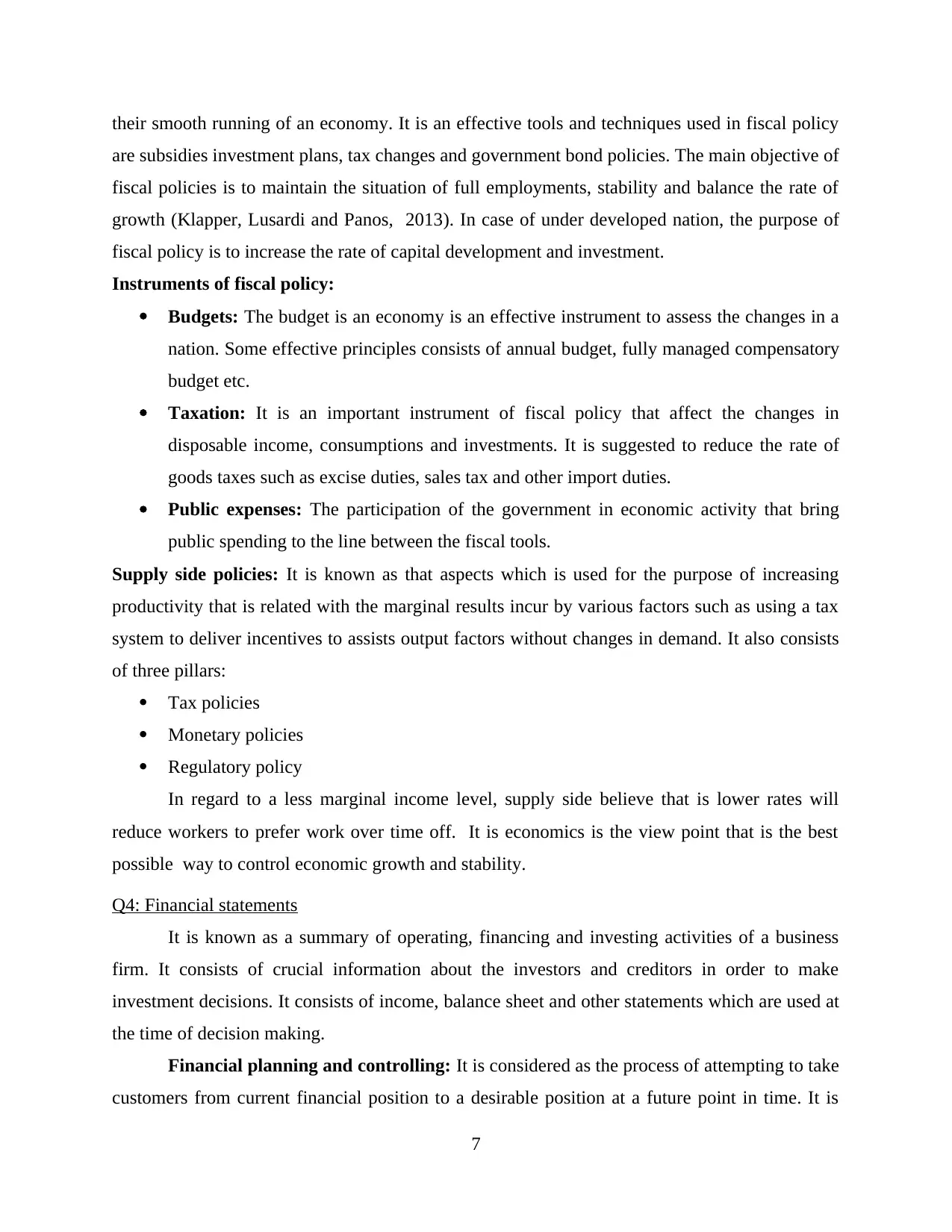
their smooth running of an economy. It is an effective tools and techniques used in fiscal policy
are subsidies investment plans, tax changes and government bond policies. The main objective of
fiscal policies is to maintain the situation of full employments, stability and balance the rate of
growth (Klapper, Lusardi and Panos, 2013). In case of under developed nation, the purpose of
fiscal policy is to increase the rate of capital development and investment.
Instruments of fiscal policy:
Budgets: The budget is an economy is an effective instrument to assess the changes in a
nation. Some effective principles consists of annual budget, fully managed compensatory
budget etc.
Taxation: It is an important instrument of fiscal policy that affect the changes in
disposable income, consumptions and investments. It is suggested to reduce the rate of
goods taxes such as excise duties, sales tax and other import duties.
Public expenses: The participation of the government in economic activity that bring
public spending to the line between the fiscal tools.
Supply side policies: It is known as that aspects which is used for the purpose of increasing
productivity that is related with the marginal results incur by various factors such as using a tax
system to deliver incentives to assists output factors without changes in demand. It also consists
of three pillars:
Tax policies
Monetary policies
Regulatory policy
In regard to a less marginal income level, supply side believe that is lower rates will
reduce workers to prefer work over time off. It is economics is the view point that is the best
possible way to control economic growth and stability.
Q4: Financial statements
It is known as a summary of operating, financing and investing activities of a business
firm. It consists of crucial information about the investors and creditors in order to make
investment decisions. It consists of income, balance sheet and other statements which are used at
the time of decision making.
Financial planning and controlling: It is considered as the process of attempting to take
customers from current financial position to a desirable position at a future point in time. It is
7
are subsidies investment plans, tax changes and government bond policies. The main objective of
fiscal policies is to maintain the situation of full employments, stability and balance the rate of
growth (Klapper, Lusardi and Panos, 2013). In case of under developed nation, the purpose of
fiscal policy is to increase the rate of capital development and investment.
Instruments of fiscal policy:
Budgets: The budget is an economy is an effective instrument to assess the changes in a
nation. Some effective principles consists of annual budget, fully managed compensatory
budget etc.
Taxation: It is an important instrument of fiscal policy that affect the changes in
disposable income, consumptions and investments. It is suggested to reduce the rate of
goods taxes such as excise duties, sales tax and other import duties.
Public expenses: The participation of the government in economic activity that bring
public spending to the line between the fiscal tools.
Supply side policies: It is known as that aspects which is used for the purpose of increasing
productivity that is related with the marginal results incur by various factors such as using a tax
system to deliver incentives to assists output factors without changes in demand. It also consists
of three pillars:
Tax policies
Monetary policies
Regulatory policy
In regard to a less marginal income level, supply side believe that is lower rates will
reduce workers to prefer work over time off. It is economics is the view point that is the best
possible way to control economic growth and stability.
Q4: Financial statements
It is known as a summary of operating, financing and investing activities of a business
firm. It consists of crucial information about the investors and creditors in order to make
investment decisions. It consists of income, balance sheet and other statements which are used at
the time of decision making.
Financial planning and controlling: It is considered as the process of attempting to take
customers from current financial position to a desirable position at a future point in time. It is
7
⊘ This is a preview!⊘
Do you want full access?
Subscribe today to unlock all pages.

Trusted by 1+ million students worldwide
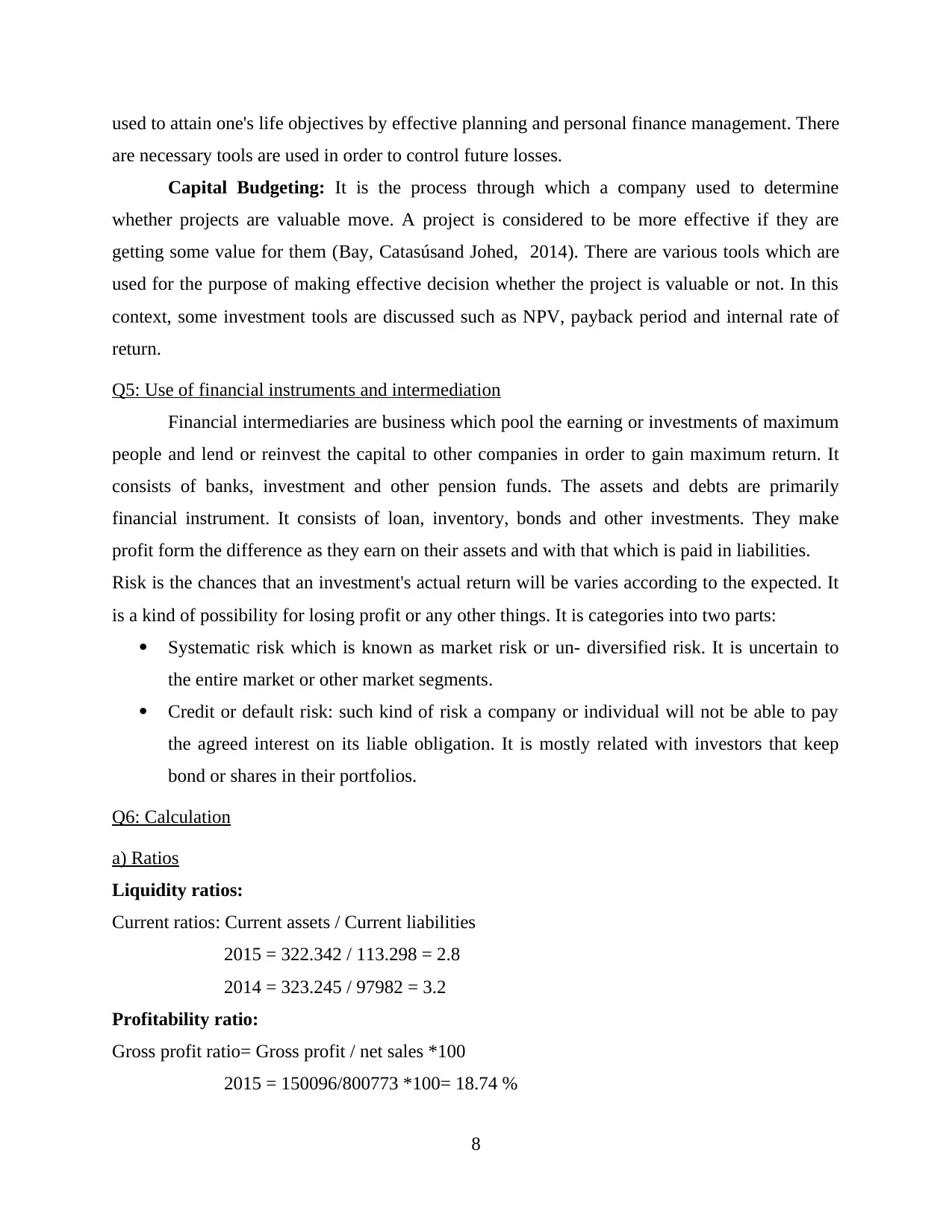
used to attain one's life objectives by effective planning and personal finance management. There
are necessary tools are used in order to control future losses.
Capital Budgeting: It is the process through which a company used to determine
whether projects are valuable move. A project is considered to be more effective if they are
getting some value for them (Bay, Catasúsand Johed, 2014). There are various tools which are
used for the purpose of making effective decision whether the project is valuable or not. In this
context, some investment tools are discussed such as NPV, payback period and internal rate of
return.
Q5: Use of financial instruments and intermediation
Financial intermediaries are business which pool the earning or investments of maximum
people and lend or reinvest the capital to other companies in order to gain maximum return. It
consists of banks, investment and other pension funds. The assets and debts are primarily
financial instrument. It consists of loan, inventory, bonds and other investments. They make
profit form the difference as they earn on their assets and with that which is paid in liabilities.
Risk is the chances that an investment's actual return will be varies according to the expected. It
is a kind of possibility for losing profit or any other things. It is categories into two parts:
Systematic risk which is known as market risk or un- diversified risk. It is uncertain to
the entire market or other market segments.
Credit or default risk: such kind of risk a company or individual will not be able to pay
the agreed interest on its liable obligation. It is mostly related with investors that keep
bond or shares in their portfolios.
Q6: Calculation
a) Ratios
Liquidity ratios:
Current ratios: Current assets / Current liabilities
2015 = 322.342 / 113.298 = 2.8
2014 = 323.245 / 97982 = 3.2
Profitability ratio:
Gross profit ratio= Gross profit / net sales *100
2015 = 150096/800773 *100= 18.74 %
8
are necessary tools are used in order to control future losses.
Capital Budgeting: It is the process through which a company used to determine
whether projects are valuable move. A project is considered to be more effective if they are
getting some value for them (Bay, Catasúsand Johed, 2014). There are various tools which are
used for the purpose of making effective decision whether the project is valuable or not. In this
context, some investment tools are discussed such as NPV, payback period and internal rate of
return.
Q5: Use of financial instruments and intermediation
Financial intermediaries are business which pool the earning or investments of maximum
people and lend or reinvest the capital to other companies in order to gain maximum return. It
consists of banks, investment and other pension funds. The assets and debts are primarily
financial instrument. It consists of loan, inventory, bonds and other investments. They make
profit form the difference as they earn on their assets and with that which is paid in liabilities.
Risk is the chances that an investment's actual return will be varies according to the expected. It
is a kind of possibility for losing profit or any other things. It is categories into two parts:
Systematic risk which is known as market risk or un- diversified risk. It is uncertain to
the entire market or other market segments.
Credit or default risk: such kind of risk a company or individual will not be able to pay
the agreed interest on its liable obligation. It is mostly related with investors that keep
bond or shares in their portfolios.
Q6: Calculation
a) Ratios
Liquidity ratios:
Current ratios: Current assets / Current liabilities
2015 = 322.342 / 113.298 = 2.8
2014 = 323.245 / 97982 = 3.2
Profitability ratio:
Gross profit ratio= Gross profit / net sales *100
2015 = 150096/800773 *100= 18.74 %
8
Paraphrase This Document
Need a fresh take? Get an instant paraphrase of this document with our AI Paraphraser
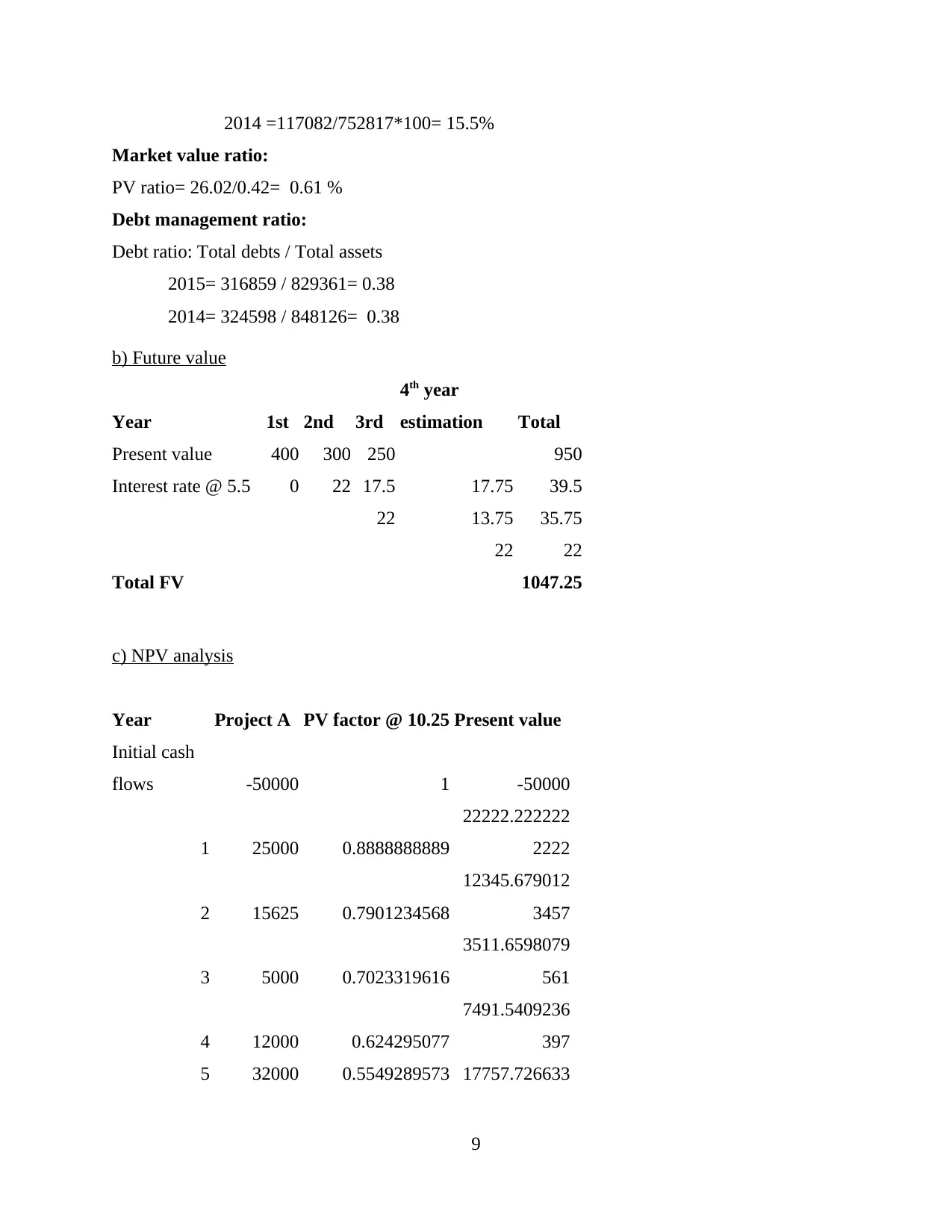
2014 =117082/752817*100= 15.5%
Market value ratio:
PV ratio= 26.02/0.42= 0.61 %
Debt management ratio:
Debt ratio: Total debts / Total assets
2015= 316859 / 829361= 0.38
2014= 324598 / 848126= 0.38
b) Future value
Year 1st 2nd 3rd
4th year
estimation Total
Present value 400 300 250 950
Interest rate @ 5.5 0 22 17.5 17.75 39.5
22 13.75 35.75
22 22
Total FV 1047.25
c) NPV analysis
Year Project A PV factor @ 10.25 Present value
Initial cash
flows -50000 1 -50000
1 25000 0.8888888889
22222.222222
2222
2 15625 0.7901234568
12345.679012
3457
3 5000 0.7023319616
3511.6598079
561
4 12000 0.624295077
7491.5409236
397
5 32000 0.5549289573 17757.726633
9
Market value ratio:
PV ratio= 26.02/0.42= 0.61 %
Debt management ratio:
Debt ratio: Total debts / Total assets
2015= 316859 / 829361= 0.38
2014= 324598 / 848126= 0.38
b) Future value
Year 1st 2nd 3rd
4th year
estimation Total
Present value 400 300 250 950
Interest rate @ 5.5 0 22 17.5 17.75 39.5
22 13.75 35.75
22 22
Total FV 1047.25
c) NPV analysis
Year Project A PV factor @ 10.25 Present value
Initial cash
flows -50000 1 -50000
1 25000 0.8888888889
22222.222222
2222
2 15625 0.7901234568
12345.679012
3457
3 5000 0.7023319616
3511.6598079
561
4 12000 0.624295077
7491.5409236
397
5 32000 0.5549289573 17757.726633
9
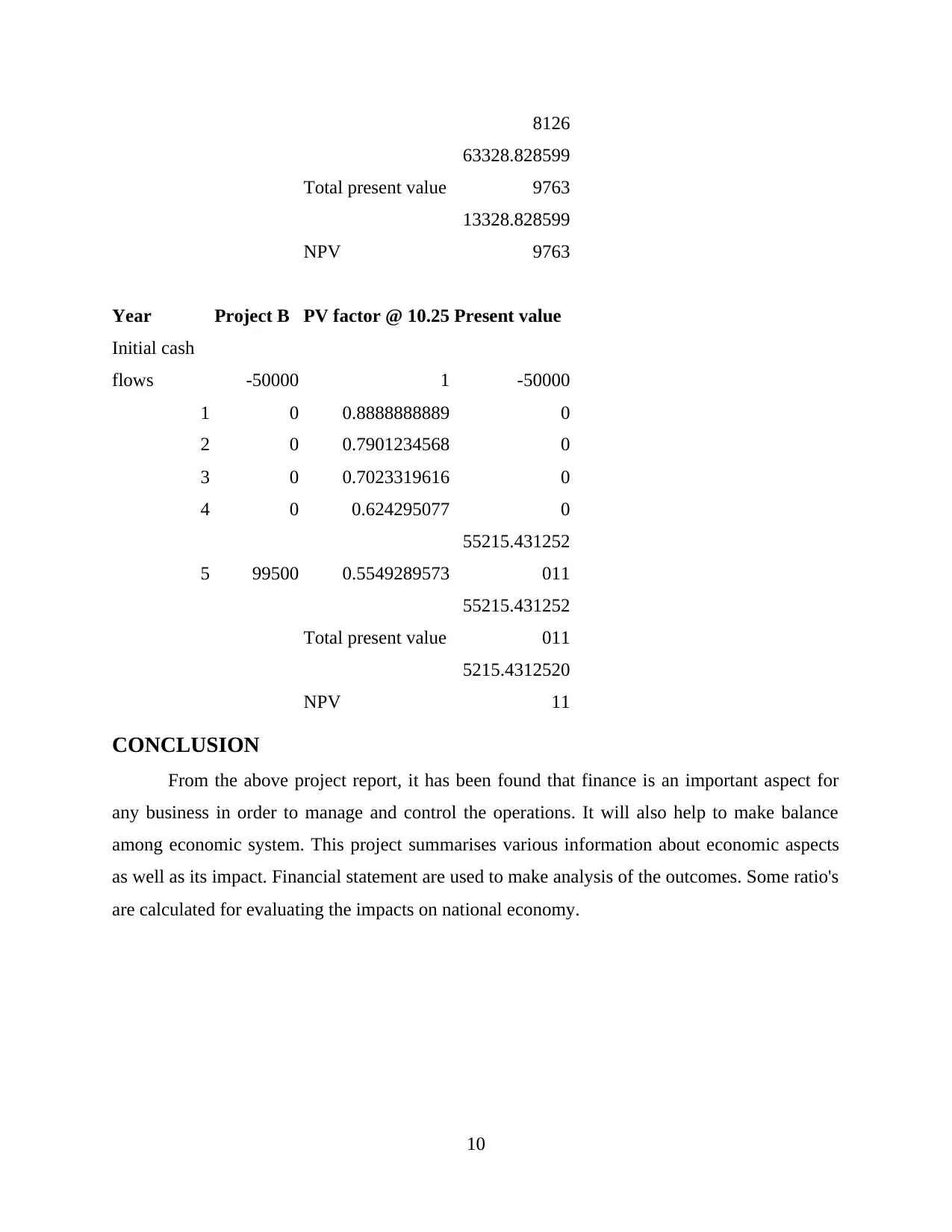
8126
Total present value
63328.828599
9763
NPV
13328.828599
9763
Year Project B PV factor @ 10.25 Present value
Initial cash
flows -50000 1 -50000
1 0 0.8888888889 0
2 0 0.7901234568 0
3 0 0.7023319616 0
4 0 0.624295077 0
5 99500 0.5549289573
55215.431252
011
Total present value
55215.431252
011
NPV
5215.4312520
11
CONCLUSION
From the above project report, it has been found that finance is an important aspect for
any business in order to manage and control the operations. It will also help to make balance
among economic system. This project summarises various information about economic aspects
as well as its impact. Financial statement are used to make analysis of the outcomes. Some ratio's
are calculated for evaluating the impacts on national economy.
10
Total present value
63328.828599
9763
NPV
13328.828599
9763
Year Project B PV factor @ 10.25 Present value
Initial cash
flows -50000 1 -50000
1 0 0.8888888889 0
2 0 0.7901234568 0
3 0 0.7023319616 0
4 0 0.624295077 0
5 99500 0.5549289573
55215.431252
011
Total present value
55215.431252
011
NPV
5215.4312520
11
CONCLUSION
From the above project report, it has been found that finance is an important aspect for
any business in order to manage and control the operations. It will also help to make balance
among economic system. This project summarises various information about economic aspects
as well as its impact. Financial statement are used to make analysis of the outcomes. Some ratio's
are calculated for evaluating the impacts on national economy.
10
⊘ This is a preview!⊘
Do you want full access?
Subscribe today to unlock all pages.

Trusted by 1+ million students worldwide
1 out of 13
Related Documents
Your All-in-One AI-Powered Toolkit for Academic Success.
+13062052269
info@desklib.com
Available 24*7 on WhatsApp / Email
![[object Object]](/_next/static/media/star-bottom.7253800d.svg)
Unlock your academic potential
Copyright © 2020–2025 A2Z Services. All Rights Reserved. Developed and managed by ZUCOL.





